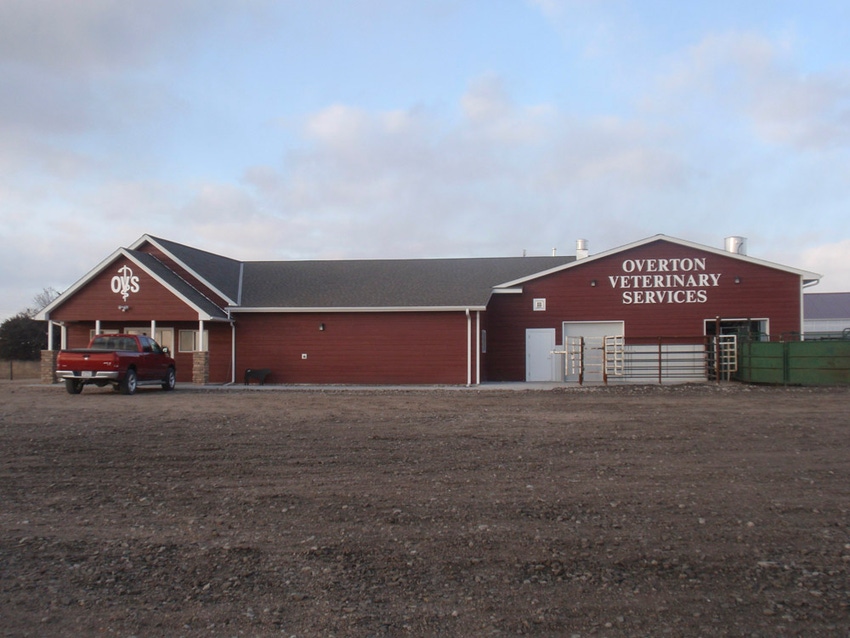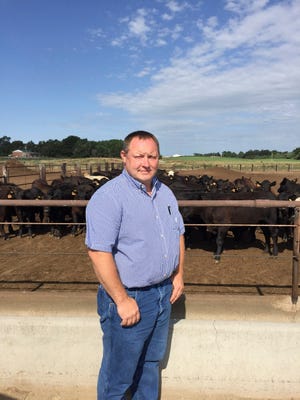Ongoing challenges faced by those in every sector of the cattle business increases the need to find folks qualified, willing and able to take care of cattle. Here's why you should be that person as their veterinarian.
September 19, 2016

Nebraska’s Overton Veterinary Services has built a business by offering solutions to specific client needs.
“Any time you can sit down with clients one on one and get a sense of the direction they have for their operations, then there is always a chance to find a way to benefit them,” says Jared Walahoski, DVM, one of the owner-partners of Overton Veterinary Services LLC (OVS) at Overton.
This statement goes a long way in explaining the number of innovative ways that OVS serves its clients — about 85% cattle (60% cow-calf and 40% feedlot), with the remainder equine and companion animal.
Consider that OVS staff are the processing crew for Darr Feedlot Inc., at Cozad, Neb. It’s a custom feedlot with a one-time capacity of about 50,000 head. Built upon a longstanding relationship forged with trust, OVS agreed to provide Darr with a processing crew in 1997, when the cattle feeding operation was much smaller.
“As Darr has grown, our staff has grown to meet their needs,” Walahoski explains. “Our commitment to them is to provide trained, BQA-certified staff to process their cattle.” The processing staff always includes at least one of the five OVS veterinarians. One way or the other, Walahoski — consulting veterinarian for Darr — is at the feedlot most every day, unlike the weekly or every-other-week schedule common to consultants.
“It lets the feedlot staff do their jobs more efficiently,” Walahoski says of the OVS processing. “From the perspective of feedlot customers, we feel like it should also provide added confidence.”
The need and opportunity to provide processing expertise and labor has everything to do with the ongoing challenge faced by those in every sector of the cattle business to find folks qualified, willing and able to take care of cattle.
Other services
In fact, providing manpower to cow-calf clients is one of the fastest growing parts of OVS. Understand that many of their cow-calf clients also farm extensively.
As a client, you can sort the calves off from your cows and send them to the OVS facility, or have the OVS crew come to your place with a four-man crew and one of their recently purchased hydraulic calf cradles. OVS does it all — castrate, dehorn, vaccinate and all the rest, documenting and tying the work to individual animal identity. OVS processed between 11,000 and 12,000 calves for clients this spring.
Although some OVS clients continue to use cow herd management software programs to track individual animal performance — OVS also provides the service — Walahoski explains that some are drifting back to the group data approach because of the labor required to input and maintain data, especially when more than one person is involved in data collection.

Jared Walahoski, DVM
Jared Walahoski, DVM“The labor pool of people who want to work hard and work in the cattle industry is getting smaller,” Walahoski emphasizes. “We have a large number of people on our staff trained to work cattle.”
Many of the OVS staff assistants have been with the clinic at least five years. Besides having the requisite processing expertise, they’re familiar with the clients and their operations, and the clients are familiar with having them around.
Counting the veterinarians, there are 16 OVS employees.
More on manpower
“We have to make sure that continues to be the case. Our clients have come to expect that from us,” Walahoski says. “When the need arises, we have to make sure we continue to find qualified people who care about the industry and are looking for a career rather than a job to get them by.”
Walahoski believes the industry needs to spend more resources in figuring out how to entice young people to get involved, or remain involved, in the cattle business.
Improving cattle care
Working with Darr Feeders and other cattle feeding clients offers Overton Veterinary Services additional opportunity to help cow-calf clients prepare calves for the market channel.
“By and large, all calves are going to end up at a feedyard. I want the calves our practice takes care of to be as prepared as possible for that environment,” Walahoski explains. “We want to have calves prepared from both a health standpoint, and in terms of nutrition and minerals.”
OVS has a staff nutritionist who works with client rations, but also helps the clinic offer clients an optimized mineral mix for specific situations, at the correct time.
Similarly, OVS uses autogenous vaccines in order to customize prevention for specific situations and threats.
“Because we have so many retained-ownership cattle at Darr, if there’s an issue, we have the ability and leeway to go back and visit with the producer to make suggestions,” Walahoski says. “If we can get them to deal with preparing calves on the front end, it minimizes problems at the feedlot.”
Some of the calves fed at Darr come from OVS cow-calf clients. When it comes to those, Walahoski explains, “We’ve seen those cattle once, if not twice, before they arrive at the yard. Our vaccination program at branding and preweaning is fairly aggressive.
“At the feedyard, you can see the difference in cattle that have been weaned and preconditioned properly,” he says.
In other words, it’s harder to be a hero taking care of health and nutrition on one side of the trade, and then processing cattle with that knowledge once they get to the feedyard. There just aren’t many health problems.
“Our expectations and those of our customers are higher,” Walahoski says. But, he adds, “I think there is always an opportunity for veterinary practices to help their clients improve their vaccination programs — not necessarily in the vaccinations given, but in making sure they’re given at the right time, and making sure cattle are prepared to enter the feedyard.”
From an industry standpoint, Walahoski continues to be frustrated by the diverse definitions of preconditioning and the lack of standardization.
Walahoski understands that OVS is blessed with a willing clientele.
“That’s part of what drew me here,” Walahoski says. “We have a group of cow-calf clients who are concerned about what they’re doing. We have a very loyal and committed client base in tune with what we’re trying to do.”
This relationship-based approach means there’s more opportunity for OVS veterinarians and their clients to learn from one another.
As Walahoski says, “Once health is taken care of, how did the cattle perform?” That leads to conversations about genetic selection, reproduction management, herd nutrition and all of the rest. OVS clients have access to a complete menu of services, from estrus synchronization and artificial insemination, to embryo flushing and transfer, to records management and herd financial analysis.
“The big thing for us is being able to spend time with our clients to identify their needs,” Walahoski explains. “We’re not trying to reinvent the wheel, or push things that don’t benefit the client. We focus on finding areas where our clients need assistance, and we provide them with solutions.”
For the folks at OVS, serving clients boils down to taking care of details. Or, as the longtime
OVS philosophy goes, “Do the common things uncommonly well.”
VFD opportunities
Though looming implementation of the Veterinary Feed Directive (VFD) will undoubtedly come with a few potholes and speed bumps, the veterinarians at Overton Veterinary Services LLC at Overton, Neb., believe it offers more opportunity than challenge.
“At the end of the day, we all have to make sure consumers purchasing beef are comfortable with the product,” says Jared Walahoski, DVM, one of the owner-partners at OVS.
On the other side of the animal care equation is the need to preserve the opportunity to use antimicrobials.
“Our program is designed to be as much of a preventative health program as it can be. By and large, where
we can do that with our cow-calf clients, there are few health problems,” Walahoski explains. “That said, there
are instances, from an animal welfare standpoint, where using antibiotics in feed and water is a superior option to putting animals through the stress of individual handling, which is why we need to embrace the fact that there will be oversight.”
OVS has been preparing clients for VFD for more than a year with educational meetings. They’re also taking a proactive approach with feed dealers serving their clients to ensure that the paperwork is in place so that clients will be able to get the products they need without interruption.
“Our goal is to make it as painless as possible for our clients,” Walahoski says.
You might also like:
Young ranchers, listen up: 8 tips from an old-timer on how to succeed in ranching
13 utility tractors that will boost efficiency in 2016
Burke Teichert: How to cull the right cow without keeping records
3 weaning methods compared; Which one rises to the top?
6 tips for proper electric fence grounding
9 things to include in your ag lease (that you better have in writing!)
About the Author(s)
You May Also Like





